designation
telescope (aperture), magnification, limiting magnitude, description, [sketch]
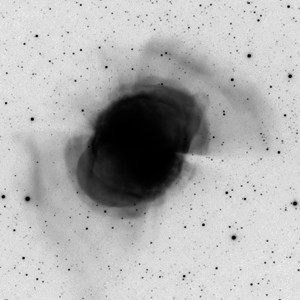
[OIII], Steve Richards
recombination halo
14", 100x, [OIII], fst 7m0+
under very good transparency NW arc easy noticeable, direct vision
detail
16", 129x, [OIII],
fst 7m0+
arc to the NW easier; sure and steadily detection with averted
vision, starts on a 13mag double star and run 4' to the SW; E arc more
difficult and only popping in and out of view with averted vision,
shorter, starts on a 9mag star and runs to the N
27", 172x, [OIII], fst 6m5+
NW arc direct visible as a 4' long glow; E arc more difficult and
despite the aperture hard to see without the exact knowledge of the
position, longish glow just N of a 9mag star, seems to be larger than on
photos
sketch
27",
113x-172x, [OIII], fst 7m0+
Under better transparency, the
whole NW halo fragment extends tremendously starting from the direct
visible thin and only slightly bend arc directly north of the PN shell
to the SW. The halo turns until it touches the showy gap at the SW side
of the main body. It is fully filled with nebula and around 9' long. The
whole SE fragment again seems to be much fainter and only pops out
directly west of the 9mag HD 345464 and fills the gap as a very faint
filling towards the PN. Interestingly the smaller EP of 4mm (172x) with
its better image scale let the halo became visible more easily than the
EP of 6mm (113x).
27", 113x, [OIII], fst 7m0+
Under exceptional transparency and darkness the halo became a huge and
detailed part of M 27. Spanning an area of 15'x11', the halo is
connected directly on the two brighter shells at the NW and SE edge of
the bright rims of the PN. Brightest part of the NE segment starts
around an 13mag double star, moving south with two brighter and wider
rims. The prominent filling between the outer edge and the shell is most
striking at the SW end. The SE segment is again much fainter but also
shows a brighter rim and a very faint filling towards the PN shell.
Beside the tow main halo fragments, some more smaller structures are
attached directly on the shells like a fainter nebula in the NE and a
somewhat detached plob in the NW.
sketch
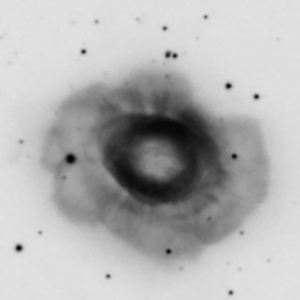
[OIII], Bill Snyder
first halo =
recombination halo
16", 106x-180x, UHC, fst 7m0+
difficult confirmation on the long NW side because of a 14mag star
chain at the diameter of the halo; best filter for 16" UHC; from 106x
faint irregularities along the outer SE side suspected but to small to
confirm, with 180x and exactly at the S tip a 0,5' long glow can be seen,
confusion with a 15mag star excluded; another fainter section suspected,
starting from the 9mag star at the E side and runs 0,5' to the SW;
complete ring around the PN not visible
sketch
27", 244x,
UHC, fst 7m0+
the inner circle of the halo can be detected with 3mm EP and UHC filter;
closed ring with 2,5' diameter (2x-2,5x diameter of the core); shape of the halo similar to the elongated
core; brightest part
to the SW side
48", 203x-488x, NPB, fst 7m0+
with 203x and NPB
bright and direct vision glow around the bright core; 3:2 elongated with
2,5'x2' diameter; with 488x brighter fringes/ejections which sits
directly on the bright rim of the core are directly visible
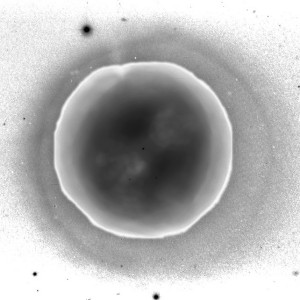
[OIII], Corradi et al. (2003)
recombination halo
27", 113x, [OIII], fst 7m0+
very difficult and faint; halo visible around a half ring from SE over
NE till NW; brightest segment to the NE, just S of the 12mag foreground
star; another brighter laminar knot to the starting point at the SE; the
whole SW side not visible
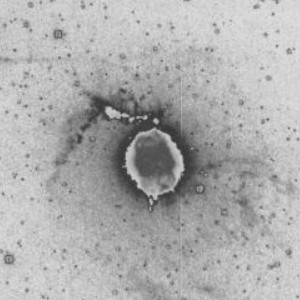
Hα, Balick et al. (1992)
27", 172x-293x, fst 7m0+
even under superb conditions nothing visible or suspected with all filter combinations
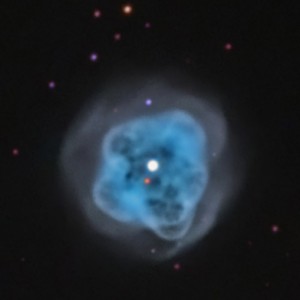
Hα/[OIII]/RGB, Don Goldman
recombination halo?
27", 172x, [OIII], fst 7m0+
halo visible as a very faint glow around the NE, NW and SW side of the
bright core; nothing visible at the SE side; only around 0,5' thick and
attached to the core
sketch
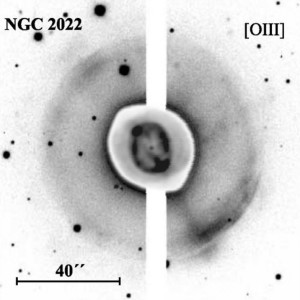
[OIII], Corradi et al. (2003)
27", 172x-293x, [OIII], fst 7m0+
difficult and very faint halo; three brightness levels; first the inner core with a bright rim and a knot to the SW; second the also bright shell with 2x diameter of the inner core; and third the very faint outer AGB halo; the halo is not steadily visible with averted vision and only popping in and out of view, a brighter knot at the SW rim (similar to the knot at the rim of the inner core) is also popping in and out; both details - halo and knot not visible at the same time; both details also visible with 172x and 293x
sketch
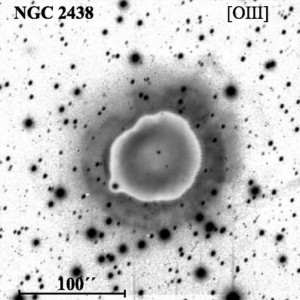
[OIII], Corradi et al. (2003)
first halo = recombination halo
27", 113x-172x, [OIII], fst 7m0+
even under superb conditions nothing visible or suspected with all filter combinations
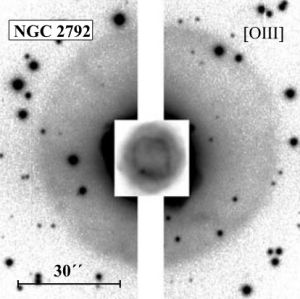
[OIII], Corradi et al. (2003)
32", 180x - 235x, [OIII], fst 7m5+
even under perfect transparency and two independent tries, the halo could only be suspected; along the western side, an extremely faint glow is popping in and out of view - no sure observation
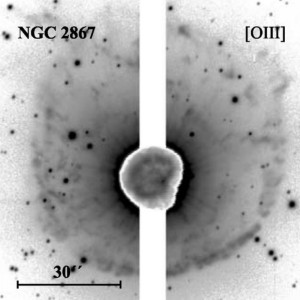
[OIII], Corradi et al. (2003)
28", 313x, [OIII], fst 7m5+
under best transparency halo even visible without filter; with [OIII] bright and direct vision, round, no bright rim
sketch
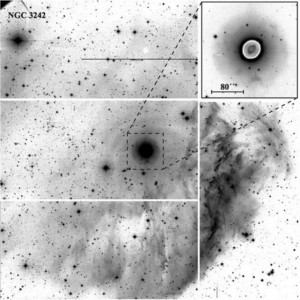
Hα, Corradi et al. (2003)
20", 114x-194x, [OIII] fst 7m0+
- inner halo: very faint but clearly visible with averted vision + [OIII] filter and 114x; 3x-4x diameter of the bright inner core + shell (~3' diameter); knot to the S popping in and out of view with 194x
- outer halo: brightest part suspected even without filter W of the PN core; with [OIII] and 114x (4,4mm EP) easy to hold with averted vision, brightest part around 9' SW of the PN core with brighter rim to the E edge, fainter and narrower outgoing to the S; UHC with worsen reaction
sketch
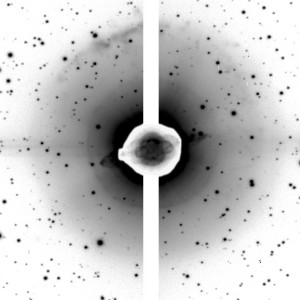
[OIII], Corradi et al. (2003)
28", 195x-391x, [OIII], fst 7m5+
bright (inner) halo around very bright core; good reaction with [OIII]; halo reaches just above a double star NW, around 1' diameter; jet to the SE within the inner halo
32", 235x, [OIII], fst 7m5+
halo even visible without any filter; the [OIII] brings
out a prominent round glow with an diameter of around 2', it touches a
15mag star in the SSW and ends up shortly before an 14mag star in the W;
the halo is uniformly illuminated and shows diffuse edges
sketch
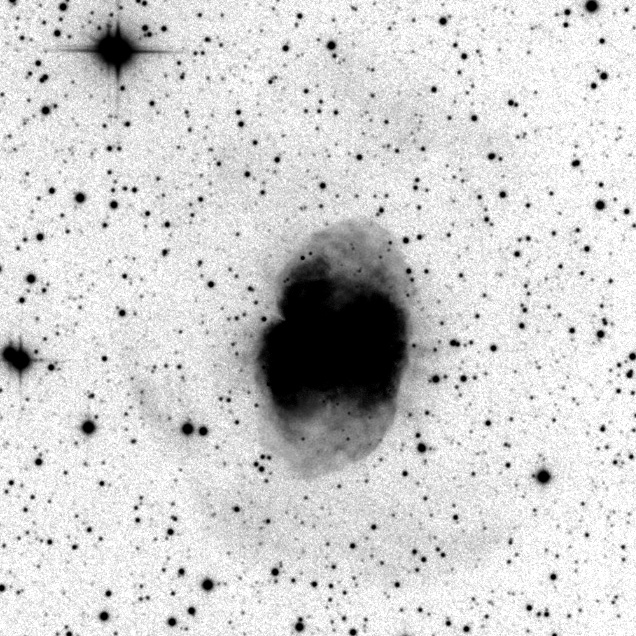
[OIII], Johannes Schedler (Chart32)
32", 145x-235x, [OIII], fst 7m5+
extremly difficult, even under perfect transparency and dark Namibian skies; halo is only suspected as a quarter circle, touching the southern edge of the main body
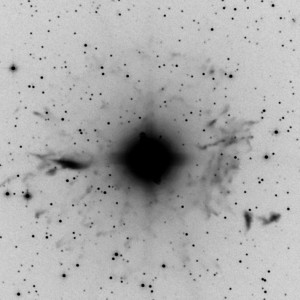
[OIII], Johannes Schedler (Chart32)
28", 260x, [OIII], fst 7m5+
PN core surrounded and attached by an direct visible 1:2 shell; brightest filamentary halo fragment 1' E of the core, steadily visible with averted vision as an 1:2 E-W glow, visible from 184x-447x, best magnification 260x + [OIII] filter ; two other smaller fragments 2' SW, each visible with averted vision for seconds as laminar glows
sketch
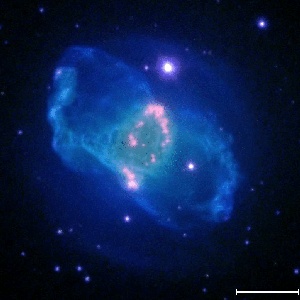
[OIII] (blue), Rubio et al. (2015)
27", 293x, [OIII], fst 6m5+
nothing visible without filter and UHC filter; [OIII] brings out a very faint round glow around very bright core; within the round glow two slightly shifted brightenings are visible, the NE one seems to be larger and longer with a not so difficult visible peak at the NE end, the SW seems to be a little bit shorter with a better defined but very unremarkable limb brightening
sketch
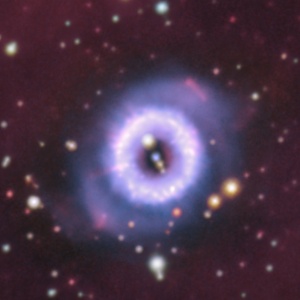
Hα/[OIII]/RGB, Don Goldman
32", 235x, [OIII], fst 7m5+
both ears to the SE and NW end at 1,5' diameter gets visible very quickly and are easy to hold with averted vision; an concentrated observation also shows a faint second layer of 1,2' all around the bright inner shell
sketch
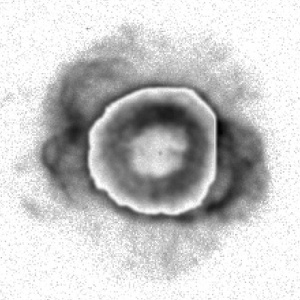
[OIII], Corradi et al. (2003)
16", 360x, no filter, fst 6m5+
with higher magnification a faint glow directly W of the ring is suspected
sketch
27", 293x, [OIII], fst 6m5+
even without filter and 172x two faint extensions to the E and W
suspected; brighter impression with UHC or [OIII]; best view with 293x +
[OIII]; two short but bright "ears" directly connected to the bright
inner ring; W glow smaller but brighter; E glow larger from E to NE but
fainter, a brighter knot is visible at the middle of the halo; nothing
visible to the N and S
sketch
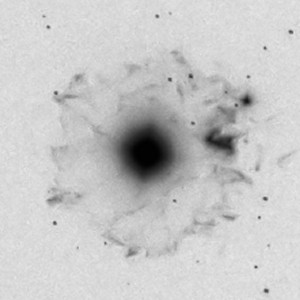
[OIII], Ricky CN
16", 51x-129x, [OIII], fst 6m5+
IC 4677 direct vision and easy visible as a 1:2 elongated knot; no other structure visible
27",
172x, [OIII] fst 6m5+
IC 4677 bright and direct vision with three peaks within the large 1:2
knot, inner halo visible as a very faint round glow, no outer halo and
no filamentary structures seen
48", 203x, NPB, fst 7m0+
IC 4677 with four knots, two brighter ones in the E in a row, at the NW
end third (second brightest) and the faintest at the SW end; around very
bright core the inner halo is visible with direct vision as a N-S
elongated glow with 1.5'x1' size; outer halo visible with averted vision,
the rim degrades in four knots, brightest knot to the ESE above a 14mag
star, the two second brightest knots to the S and NE and the faintest
knot to the W 1' under IC 4677, no inner structure visible
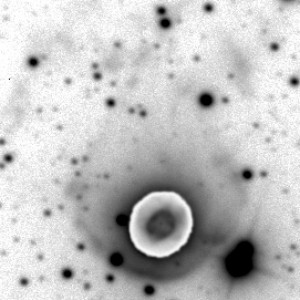
[OIII], Corradi et al. (2003)
27", 293x-419x, [OIII]/UHC, fst 7m0+
beside the very bright core (~7") and the fainter shell (~13") the halo is also suspected with 419x and UHC or/and [OIII], no sure observation; whole system very small, and deep in the sky, so it needs to much magnification?
sketch (with shell only)
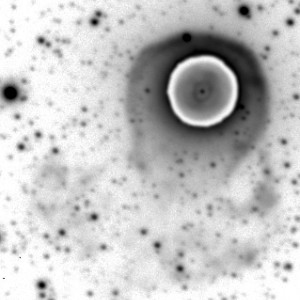
[OIII], Corradi et al. (2003)
27", 293x, [OIII], fst 7m0+
good defined and bright core of around 16"; around core very faint glow with around 3x diameter of the core, glow reaches from the rim of the core to half the way to a 15mag star; N side better defined; glow suspected even without filter, with [OIII] sure confirmation
sketch
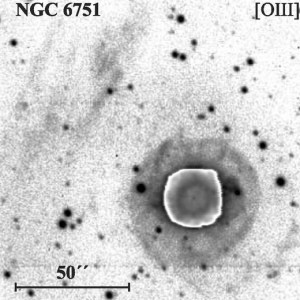
[OIII], Corradi et al. (2003)
27", 293x, [OIII]/UHC, fst 7m0+
halo only suspected to the S and to the W; no sure detection, negative observation
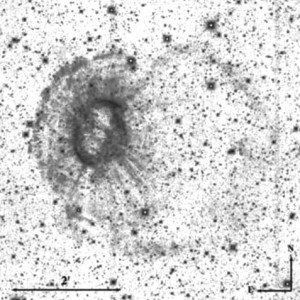
H2, Fang et al. (2018)
27", 113x-172x, [OIII], fst 7m0+
halo clearly visible as a very faint glow around the core from SE over E to N, brightest part to the E, N part very difficult and only suspected, no halo structure to the W; sure observation
sketch
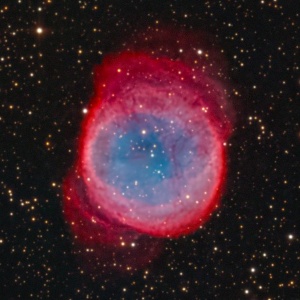
LRGB, Bob Fera/Eric Coles
27", 234x, UHC, fst 6m5+
halo is visible as a very faint rectangular extension to the north; the smaller, shorter and fainter southern extension is not visible
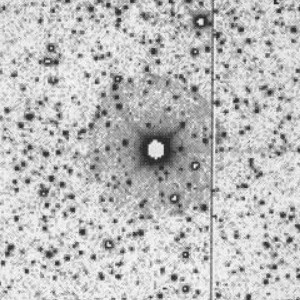
Hα/[NII], Balick et al. (1992)
27", 293x-419x, [OIII], fst 6m5+
halo only suspected; very faint glow visible at 419x, but unsure if halo or overexposure of the very bright PN core
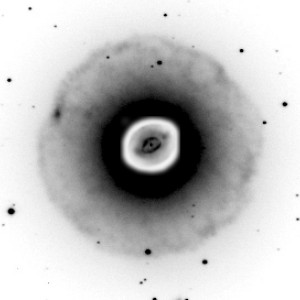
[OIII], Corradi et al. (2003)
18", 105x - 199x, [OIII], fst 5m5+
even under bright background sky and soso transparency (milky way barely visible) halo clearly detectable; with 105x small but steadily visible (averted vision), faint and round glow around bright PN shell, around four times the diameter of the inner shell, somewhat fainter but large enough with 199x, no details or structure visible
27", 172x, [OIII], fst 6m5+
halo already suspected without any filter; with [OIII] from 172x to 293x
bright and direct vision detail around the core, rim to the SW and NE
better defined, knot within the rim to the NE, filling complete within
the round glow but somewhat brighter toward the SW side
sketch
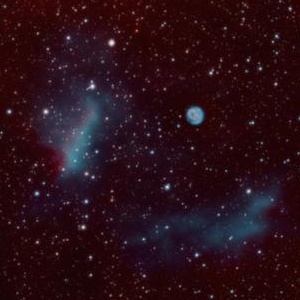
[OIII]/Hα, Peter Goodhew
27", 113x, [OIII], fst 6m5+
eastern fragment clearly
visible with [OIII] as a very faint, 1:2 N-S elongated glow, disappears
with UHC; southern fragment only suspected with UHC
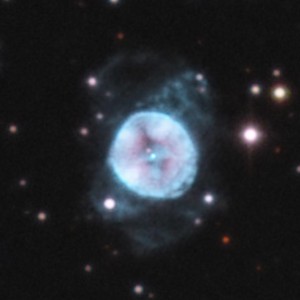
Hα/[OIII]/RGB, Johannes Schedler (Chart32)
27", 293x, [OIII], fst 6m5+
halo visible as a very faint extension from the core to the NW; difficult but sure observation; other extensions not visible
36", 578x, no filter/UHC, fst
6m5+
starting without any filter, a faint pointed extension is visible to the
NW, ending in a stellar peak; UHC brings similar results; [OIII] to dim
for the given small exit pupil; halo fragment to the SE is not visible
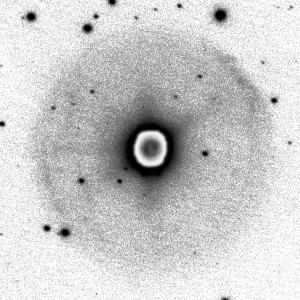
Hα, Corradi et al. (2003)
27", 172x, [OIII], fst 6m5+
halo visible as a very faint, round glow with 4mm EP and [OIII] only; not visible with higher magnifications; around 1,2' diameter; somewhat brighter within the glow at the SW side; no rim brightening
sketch
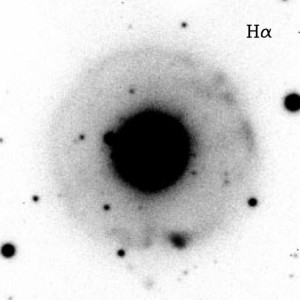
Hα, Guerrero et al. (2000)
27", 172x, [OIII], fst 7m0+
with low magnification core and shell merges as one inner and bright detail and are not separately visible; much fainter halo suspected with 113x and [OIII] and better visible with 172x; round with 3x-4x of the diameter of the shell (around 1,2'); S side (filling) a little bit better defined
sketch
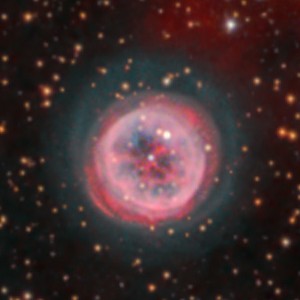
LRGB/Hα/[OIII], Bernhard Hubl
27", 293x, [OIII], fst 7m0+
bright core somewhat fringed to the SW but no second shell or round glow around the core; negative observation
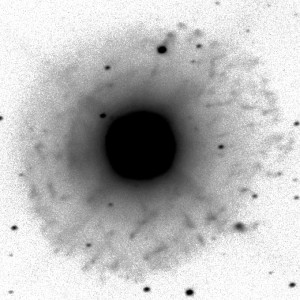
Hα, Corradi et al. (2003)
27", 172x, [OIII], fst 7m0+
even without any filter bright round glow around very briht green core; [OIII] filters brings our the halo even brighter, direct vision glow of around 4' diameter, brighter regions to the S and NE, appears somewhat scabby without showing individual spots
sketch
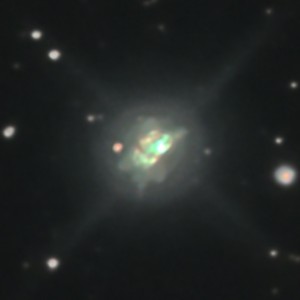
Ralf Burkart
16", 180x, [OIII], fst 6m5+
halo noticeable around the very bright core
sketch
18",
199x, [OIII], fst 5m5+
even under bright background sky and soso transparency
(milky way barely visible) halo clearly and easily detectable; fainter
glow around bright shell even without any filter, [OIII] leaves the glow
been visible as a brighter envelope three times the diameter of the PN
shell
27", 293x, [OIII], fst 7m0+
glow around very bright core even visible without filter; good reaction
with [OIII] filter; diameter of the halo reaches close up to a 14mag
star in the E and is around 1,5'; bright, 1:2 elongated core seems to be
shifted to the N within the halo, center seems to be at the S border of
the core; brightest part of the halo sits directly SW-W on the bright
core; a dark border suspected at the N end; with high magnification
brighter halo shell around core visible
sketch
(outer halo)
sketch (inner
shell)
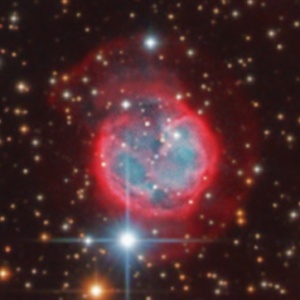
LRGB/Hα/[OIII], Bernhard Hubl
27", 172x, UHC, fst 7m0+
under very good transparency N extension up to a 13mag star only suspected with UHC; very difficult and not steadily visible; [OIII] negative results; S and W halo sides not visible
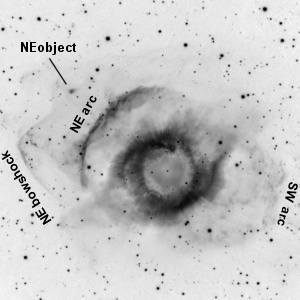
Hα/[OIII], Martin Pugh
27", 113x-172x, UHC, fst 7m0+
even under perfect conditions (47°N) of an high alpine location brightest halo arc only suspected; strong contrast effect of the bright rim of the core makes it nearly impossible to decide whether glow is the halo arc or only a contrast phenomenon; within a small triangle of 15mag stars 11' NE of the center a faint glow suspected; three observer also only suspected extremely faint glow and were not sure of a positive observation
32", 118x,
UHC, fst 7m5+
best overall filter combination is the UHC, even when
some halo segments are more prominent without any filter or/and with Hß;
even under perfect sky conditions, the brightest NE arc remains faint
and a difficult detail, this arc is visible as a relative broad curved
line at its full length without any details ore brighter sections; the
NE object is visible as a very faint diffuse glow with small size and
somewhat concentrations to its middle like a faint galaxy; the NE
bowshock is visible as an dark, snapping of edge reaching from the east,
directly at the bend a faint streak is reaching directly towards the PN
centre; the SW arc is surprisingly easy to see and reaches starting from
a star arc towards north and bends towards the NW edge of the main body
of the PN
sketch
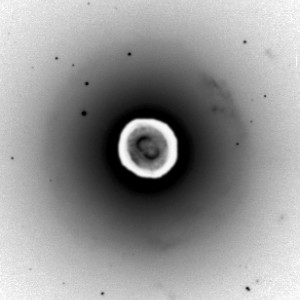
[OIII], Corradi et al. (2003)
14", 100x, [OIII], fst 7m0+
halo easy visible with averted vision as a round glow with good defined edges of around 2' diameter
27", 172x, [OIII], fst 6m5+
with [OIII] flashy glow of around 2'-2,5' diameter around the bright
core; two stars at the NE within the halo; a stellar peak is visible in
a very faint arc at the NW edge of the halo; SE part of the halo seems
to be a little bit brighter; edge sharply defined
sketch
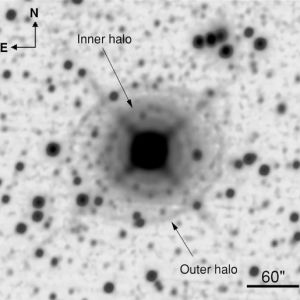
WISE (IR), Ramos-Larios et al. (2012)
27", 172x, [OIII], fst 7m0+
halo already visible as a faint glow around the bright shell with searching eyepiece at 113x without filter and is still visible up to 293x; best view with [OIII] and 172x at 4mm EP; halo visible as a bright and round glow with 2' diameter; diffuse edges with concentration towards the PN; somewhat brighter to the NE side; steadily visible with averted vision
sketch
36", 165x, [OIII], fst 7m0+
similar appearance like the 27" view but somewhat brighter; halo is
visible with [OIII] as direct vision glow around the bright shell
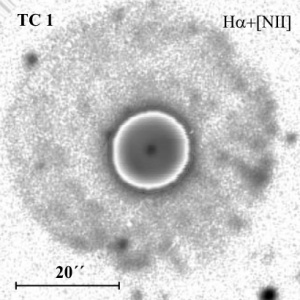
Hα/[NII], Corradi et al. (2003)
32", 306x, UHC, fst 7m5+
even though bright on the DSS plates, the halo is much more difficult to observe, than expected; even the main inner shell is hard to find and appears as a faint, very small glow around the bright central star; the halo is suspected without any filter and disappears with [OIII] filter; best filter/eyepiece combination is 306x (2,6mm EP) + UHC filter; the halo is now visible all around the inner shell as a round, structureless glow with only 0,8' diameter; S to SE side seems to be a little bit better defined but remains very faint
sketch
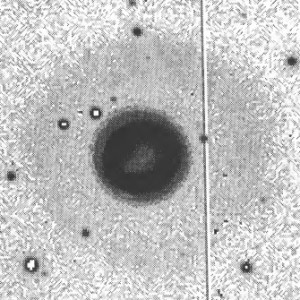
Hα/[NII], Balick et al. (1992)
27", 172x, [OIII], fst 7m0+
halo only suspected, no sure observation
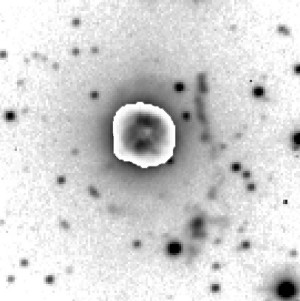
Hα/[NII], Corradi et al. (2003)
27", 113x-172x, fst 7m0+
halo definitely not visible or suspected with all filter combinations
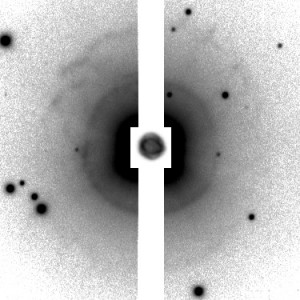
[OIII], Corradi et al. (2003)
27", 172x-293x, fst 7m0+
very faint but sure visible; round glow touches 15mag star 0,5' SE, so its diameter is around 1'; seems to be two-stage, an inner, somewhat brighter glow of around 0,5' diameter around the very small ring core and the mentioned 1' outer glow; W side of the glow somewhat better defined and visible
sketch
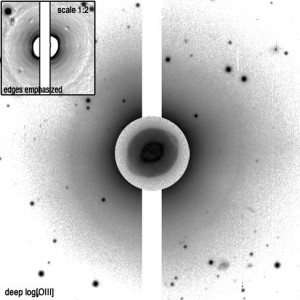
[OIII], Corradi et al. (2003)
28", 312x, [OIII], fst 7m5+
faint glow steadily visible with averted vision; round and diffse, no sharp edges
sketch
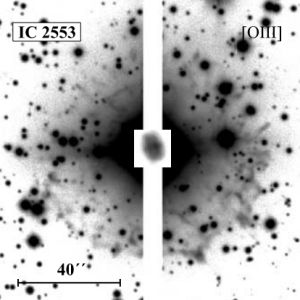
[OIII], Corradi et al. (2003)
32", 235x, [OIII], fst 7m5+
halo suspected even without any filter; with [OIII] still difficult to see and faint but clearly doable; outer diffuse edge reaches up to a 12mag star in the west and enclose two 14mag stars in the east; the whole glow seems somewhat brighter in the western half
sketch
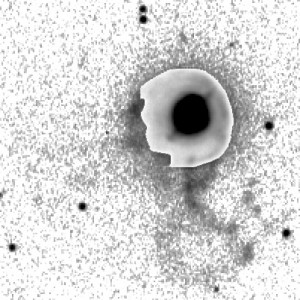
[OIII], Corradi et al. (2003)
27", 586x, fst 7m0+
halo fragment on the W side visible with high magnification and without filter, no difficult detection; faint extension to the S only suspected, no sure observation
sketch
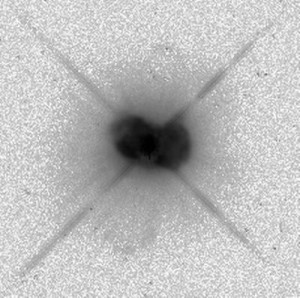
V, Bond [HST]
27", 293x-837x, fst 6m5+
brighter halo even without filter around very bright inner core; overexposure?
27", 1172x, fst 7m0+
round glow 2 x PN diameter around double core up to high magnification;
difficult to decide between halo or overexposure of the very bright core
sketch
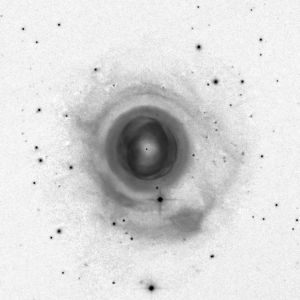
[OIII], Don Goldman
32", 118x, [OIII]. fst 7m5+
SE segment, starting from a 10mag star in the south and curving to the east suspected; detached knot in the SSW not visible
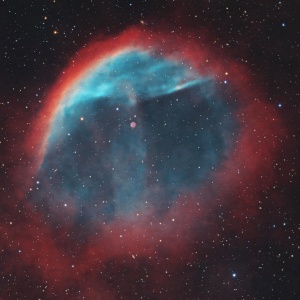
[OIII]/Hα, NHZ (Tim Schaeffer)
24", 78x, [OIII], NELM 7m5+
astonishing halo fragment, discovered in 2001 and first photographed in deep amateur images between 2017 and 2023; due to its [OIII] signal, the halo is clearly visible visually; first detail which was visible was the sharply defined curved edge, reaching from the north; brightest part starting from north and curving to the SE almost up to a faint triangle of stars, the northern edge is sharply defined while the halo is filled in direction to the PN; second and fainter half to the west starting from a brighter 10mag double star and runs straight towards the PN itself
sketch
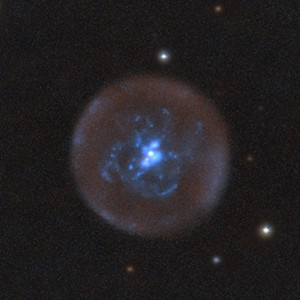
[OIII]/Hα, Ian Smith
PN without shell and shell-like core
16", 51x, [OIII],
NELM 6m5
faint PN but steadily visible with averted vision as a mid size glow
without good defined edges; only visible with maximum EP; brighter 14mag
central star
visible
sketch
27", 172x, [OIII],
NELM
6m5+, Seeing IV
with 4mm EP + [OIII] filter the PN disk itself is steadily visible with averted
vision; round with sharply defined edges; around 14mag central star a prominent but small
and structureless ~15" halo is visible; PN and halo not
visible without filter
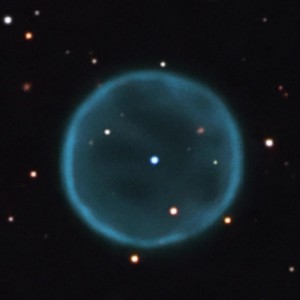
Hα/[OIII]/RGB, Don Goldman
PN without shell and shell-like core
4", 31x, [OIII],
NELM
6m2
extremely difficult to observe under average transparency and 4"
aperture; PN is popping in and out of view with 3,5mm EP and [OIII]
filter as a very faint glow which is not steadily visible even with averted vision;
positive to classify observation because of the right position of the
glow; the central star is not visible without filter
4" Binocular Telescope, 23x, [OIII], NELM 6m5+
now under better transparency of a Pre-Alpine location; but
nothing visible without filter; with 4,3mm EP and [OIII] filter a round glow is
steadily visible with averted vision; with 55x the EP is to small to
still show the PN
16", 129x, [OIII], NELM 6m5+
with [OIII] filter the PN is steadily visible with
averted vision as a large, round and structureless disc
20", 121x, [OIII], NELM 6m3
with maximum EP the PN is visible even without any
filter as a faint round glow; with 4mm
EP and [OIII] filter the disc becomes bright and is
easily visible with direct vision; somewhat darker to its middle
without showing the thin rim; the central
star is easily visible without
filter
sketch
27", 113x-172x, [OIII],
NELM 6m5+
PN even visible without a filter as a
faint round glow (with 4mm and 6mm EP); with
[OIII] filter the PN becomes an easy target and is
steadily visible with direct vision; best view with 172x (EP 4mm);
the PN looks exactly round with good defined edges; the edge
itself is visible as a
thin and segmented rim; the brightest segment is located in the
east, following with smaller segments in the NW and in
the south; the central star is easily visible without a filter,
but also shines trough the [OIII] filter;
the galaxy within the PN not attempted
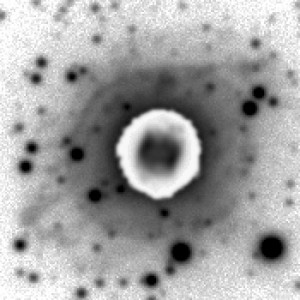
[OIII], Corradi et al. (2003)
28", 312x-843x, [OIII], fst 7m5+
faint but steadily visible halo with [OIII] and averted vision around very bright core; small, round, ~0,5' diameter halo with better defined N side
sketch
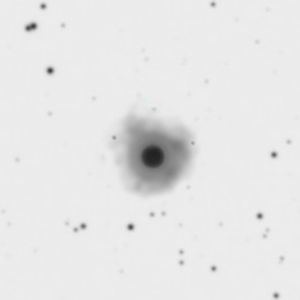
[OIII], Peter Goodhew
27", 234x, [OIII]/UHC, NELM 7m0+
under very good transparency, PN shows a clearly but very faint irregular glow around his bright central shell; the glow fits exactly to the brightest new documented halo structures; first part to see is a bean-shaped glow around the SW side of the PN, the second part is visible at the NE border, but could only be suspected; the halo is visible only with an EP of 3mm, [OIII] and UHC filter shows very similar reaction
sketch
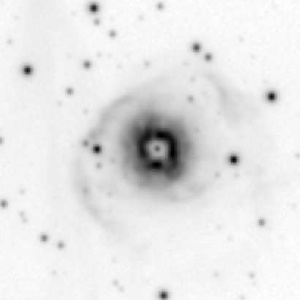
[OIII], VLT
32", 436x, [OIII], NELM 7m5+
even under perfect transparency and very dark skies, the halo is unclear and the observation brings out no sure observation of it; with 611x, a small ring can be seen directly with a popping central star; 436x + [OIII] filter does not bring out the halo clearly, it remains a suspected glow of 0,5' diameter
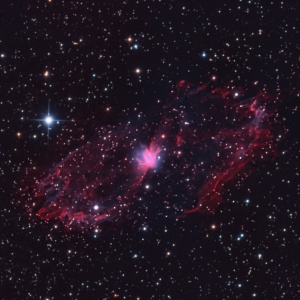
Hα/[OIII]/RGB, Don Goldman
32", 235x, UHC, NELM 7m5+
large, 11'x5' halo; very difficult and faint; best result with 235x (3,4mm EP) and UHC filter; at the SE and NW end, two very faint glows are popping in and out of view with averted vision; both segments are at the limit of perception and the observation is not sure or clear
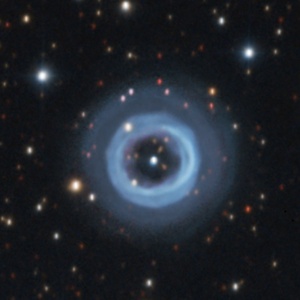
Hα/[OIII]/RGB, Don Goldman
32", 306x, [OIII], fst 7m5+
halo is already visible without any filter; [OIII] shows a good reaction and the halo gets immediately visible as a second layer outside the bright inner ring; halo shows a nearly uniform illumination with a somewhat brighter NE edge
sketch
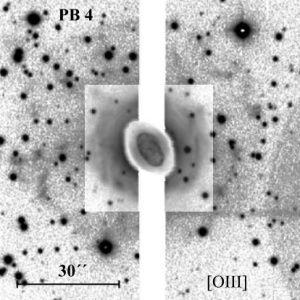
[OIII], Corradi et al. (2003)
32", 235x, [OIII], fst 7m5+
halo is not visible ore even suspected